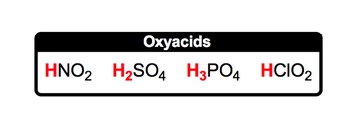Before we start naming acids, let's first talk about what exactly is an acid. Now, an acid is usually a covalent compound beginning with a hydrogen ion. So, the hydrogen ion in this case is H+. Another name for this hydrogen ion is called the hydronium ion. Now, going back to covalent, what exactly is meant by covalent compound? Well, a covalent compound is a compound that contains only nonmetals bonded together. If you don't remember who the nonmetals are, make sure you go back and take a look at my videos on the periodic table and the classifications of the elements that lie within it.
If we take a look here, some common types of acids, all of them are covalent because all of them possess nonmetals together. And since they're all covalent, we also see next that they all begin with hydrogen. That tells us that they all represent acids. So HCl, HNO2, H2SO4, we see that some of them are pretty simple like HCl and some of them are pretty complicated like H3PO4. We'll talk about the different types of acids later on and the rules associated with naming them. Now, remember, we said that they usually begin with the hydrogen ion. Usually does not mean always. And with chemistry, you're going to see that exceptions do pop up here and there. A good exception to this is acetic acid.
Acetic acid can be drawn in two different ways. The first way goes along with the definition we have. It starts with the hydrogen and it's covalent because it only has nonmetals. But another way to write acetic acid is CH3COOH. In this case, the hydrogen ion is actually written in the back. This is an exception to our definition, where this is still an acid, but it doesn't begin with the hydrogen ion. Now that we know the basic structure of an acid, let's move on to some videos and let's tackle the different types of acids that exist and the ways of naming them.



